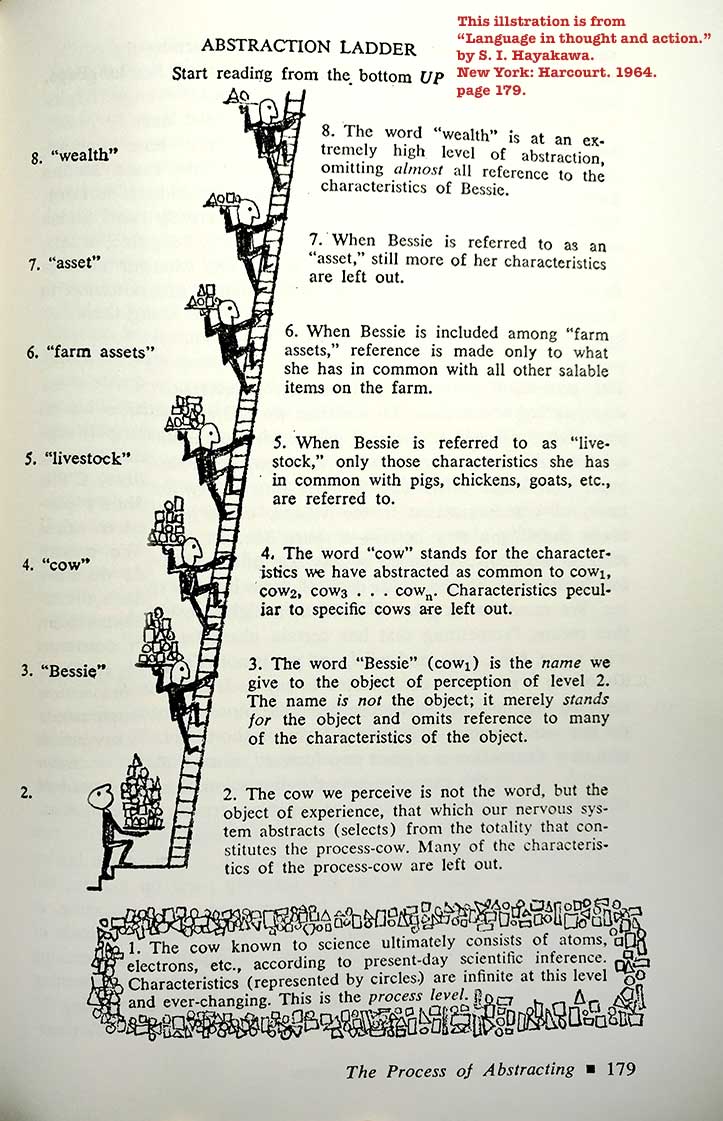Ladder of Abstraction and Definitions
•
I will confess that I never thought about definitions until I started working on this film project.
There are many words which mean different things to different people, and depending on context. The word "uncertainty" comes to mind first, but two words which are used interchangeably are "precision" and "accuracy." Most dictionaries use one to describe the other. For example, Merriam-Webster gives the "Essential Meaning of precision: the quality of being precise : exactness or accuracy. Example: 'I admire the precision of her work.'"
In metrological context, the words do not have the same meaning. Then, how could these words apply to the redefinition of the kilogram? What is the goal of the redefinition? To be more accurate? More precise?
Looking at the Recommendation G1 (2017) of the BIPM's Consultive Committee on Mass we see that the Committee recommends that four conditions to be met before redefining the kilogram. The conditions aren't numbered in the document but I will give them numbers here for easier reference.
- "at least three independent experiments, including work from Kibble balance and XRCD experiments, yield values of the Planck constant with relative standard uncertainties not larger than 5 × 10^−8 ,
- "at least one of these results should have a relative standard uncertainty not larger than 2 × 10−8 ,
- "the BIPM prototypes, the BIPM ensemble of reference mass standards, and the mass standards used in the Kibble balance and XRCD experiments have been compared as directly as possible with the international prototype of the kilogram,
- "the procedures for the future realization and dissemination of the kilogram, as described in the mise en pratique, have been validated in accordance with the principles of the CIPM MRA"
I would describe the conditions as the way to ensure both precision and accuracy. I asked Jon Pratt at NIST if he could agree with that. He considered that for a moment, and agreed.
So my descriptions are:
- Condition 1 gives a cross-check of different methods and different apparatus to get a value for the Planck constant. It also specifics a precision to be reached for the acceptable values.
- Condition 2 mandates an even finer precision for at least one experiment.
- Condition 3 connects the masses used in these experiments to the IPK. Which the goal, the bull's eyes, the "true" value.
- Condition 4 says that people have to know how to realize a kilogram, the steps to be able to say "This is a kilogram." Put another way, Condition 1+2 ensure precision. Condition 3 ensures accuracy.
Firstly, I think it's important for the film viewer to understand that such conditions exist at all. Many people I talk to have no idea how such standards and definitions get decided. I didn't either, before I started this project. I hope Kilofilm introduces this aspect of science policy.
But to understand these specific Conditions, I think we must step up the the "abstraction ladder," of S.I. Hayakawa. What do I mean by that?
In his book Language in Thought and Action, Hayakawa presents the idea of abstraction using the idea of a ladder. Here's the illustation from the 1964 edition

After the diagram and discussion on what abstraction means and how to use, Hayakawa quotes Professor Wendell Johnson's book People in Quandaries: The Semantics of Personal Adjustment (1946) to explain how the reader or audience feels when confronted for too long with a the wrong level, chosen by a speaker stuck in a specific level of abstraction:
"The low-level speaker frustrates you because he leaves you with no directions as to what to do with the basketful of information he has given you. The high-level speaker frustrates you because be simply doesn’t tell you what he is talking about...Being thus frustrated, and being further blocked because the rules of courtesy (or of attendance at class lectures) require that one remain quietly seated until the speaker has finished, there is little for one to do but daydream, doodle, or simply fall asleep."I paraphase Johnson: Too abstract, people don't know what you're talking about. Too detailed, they don't know why you're telling them.
Looking at the text of the Foiur Conditions, you see very detailed language. It's clear, but a bit long in a film. So I step up the ladder of abstraction, and use the Conditions to show how the goals are correct scientific methods (multiple instances of an experiment have to agree, and multiple approaches have to agree) and a clear improvement in precision for modern needs, and continuity with past measurements (so that the numbers for h dovetail with IPK having exactly 1 kilogram mass). Voltaire advises, "If you would converse with me, you must first define your terms."
Thus I want the film audience to think about the definitions of precision and accuracy, generally, so be ready for the nuances in the wording of the Conditions.
So I asked people at the Urbana Farmer's market about precision vs. accuracy.
All this motivation takes a miserably long time to explain. It's much faster to watch the 1:40 clip and think about your own definitions.